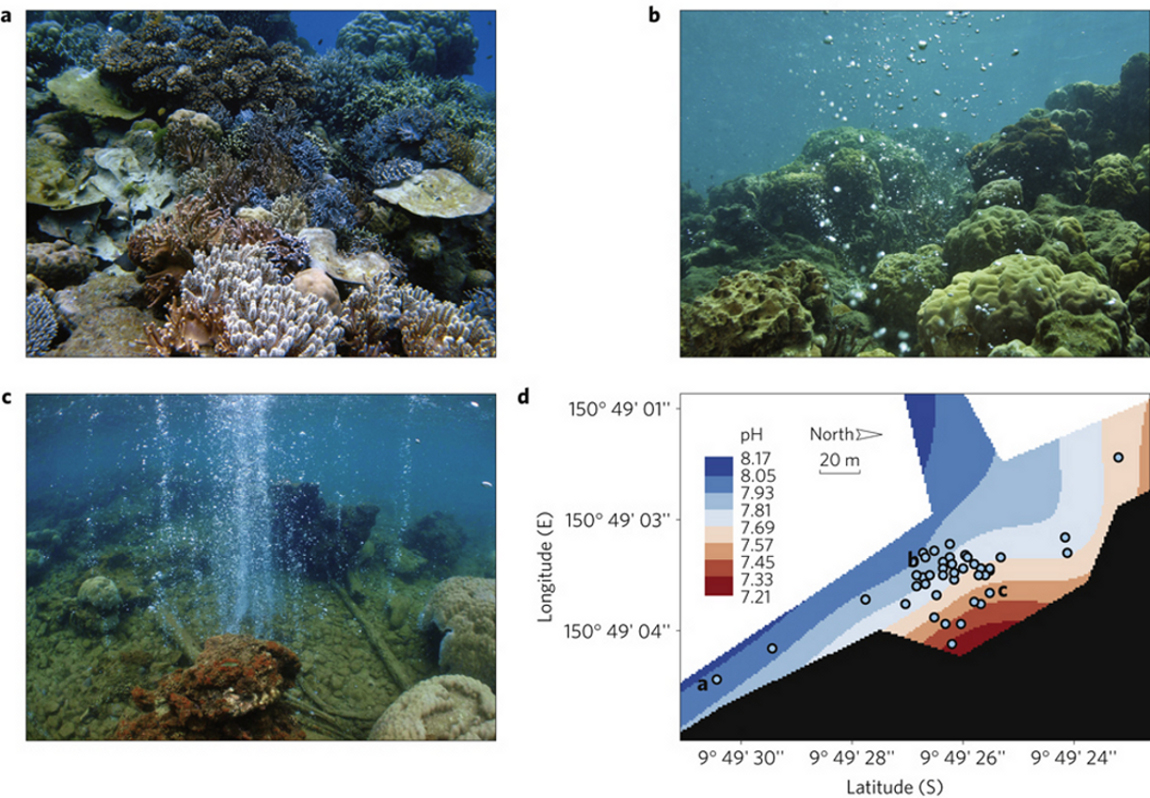
Numerous lab experiments have shown that ocean acidification is harmful to marine life. Creatures that build chalk-like shells (or skeletons) fare poorly under conditions which mimic the low ocean pH levels expected later this century. This isn't a universal response however; some starfish, brittle stars and sea urchins, seem relatively unaffected by ocean acidification, so it's likely there will be winners and losers as the world's oceans become less alkaline.
Despite their usefulness, lab experiments are no substitute for the natural environment, and experiments tend to be of short duration too, so the long-term effects of elevated CO2 on marine communities is largely unknown. Luckily there are a couple of locations in the world which mimic ocean acidification. These locations are not perfect analogues for the future, seawater acidity is not held permanently low because of seasonal wind and current variation, for example, but they do give some insight into how marine life might adapt (or not) to ocean acidification over the long haul.
Fabricius 2011 examines the coral reefs in one such area, Milne Bay Province in Papua New Guinea, where cool CO2 bubbles up through natural seeps on the seafloor, thereby lowering seawater pH. The authors examined underwater sites which are equivalent to 3 ocean pH scenarios: a control site, where seawater is at ambient (normal) pH (around 8.1), a low pH site (7.8-8.0), and a very low pH site (below 7.7).
Figure 1 -Seascapes at a, control site (‘low pCO2’: pH~8.1), b, moderate seeps (‘high pCO2’: pH 7.8–8.0), and c, the most intense vents (pH<7.7), showing progressive loss of diversity and structural complexity with increasing pCO2. d, Map of the main seep site along the western shore of Upa-Upasina. Colour contours indicate seawater pH, and the letters indicate the approximate locations of seascapes as shown in a–c.
What the authors found, is probably no surprise: as the level of seawater pH dropped from it's normal value of 8.1, the health of the reef began to deteriorate. Various hard and soft corals, and other hard-shelled marine life, such as cructose coralline algae, disappeared from the seafloor. Only one type of coral was able to tolerate ph as low as 7.8, which is equivalent to 750 ppm of atmospheric CO2: a figure we're on track to reach before the end of the 21st century. Below a pH of 7.7 however, coral reef development stopped dead in it's tracks. The beneficiaries, it turns out, are slime (macroalgae) and seagrasses, with their populations flourishing as seawater becomes more acidic.
Another discovery made by the authors, is that coral reef growth (calcification) was 30% lower than is the norm for coral reefs at similar latitude (distance from the equator), and both the low and ambient pH sites exhibited the same condition. The Milne Bay area has experienced repeated mass coral bleaching events in the last 20 years, so this has probably played a role in the low growth rates. This is consistent with the latest research showing coral growth rates have diminished worldwide in recent decades.
The work of Fabricius 2011 builds on earlier work off the island of Ischia, Italy; another area where CO2 bubbles up from the seafloor. Hall-Spencer (2008) reached similar conclusions researching the waters off Ischia; lower pH inhibited the development of calcifying marine life, and favoured the growth of seagrasses and slime. See video of the area, featuring Dr Hall-Spencer, below:
Ocean Acidification - Ischia from UNEP WCMC on Vimeo.
The potentially devastating impact of future ocean acidification is clearly obvious in the pictures above. Despite being exposed to acidic conditions for thousands of years, it seems many marine creatures can't handle ocean acidification, and the ones that do are not conducive to healthy coastal ecosystems. The loss of of cructose coralline algae is particularly important to corals, as they secrete chemicals that provide settlement cues for coral larvae, help consolidate the reef structure, and prevent the growth of slime. Without the complex structure and shelter that healthy reefs provide, many thousands of reef species, including many fish, may disappear.
Fabricius 2011 adds to the growing body of scientific research which spell out a troubling future for our oceans. There will undoubtedly be some winners as the oceans become more acidic, but just how palatable is a menu consisting of slime, seagrass and brittlestars, and the occasional sea urchin? That is something future generations may have to to ponder.
Posted by Rob Painting on Friday, 10 June, 2011
 |
The Skeptical Science website by Skeptical Science is licensed under a Creative Commons Attribution 3.0 Unported License. |